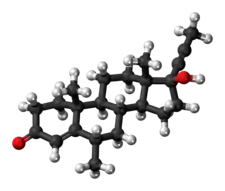 | |
 | |
| Clinical data | |
|---|---|
| Trade names | Lutagan, Secrosteron, others |
| Other names | Dimethindrone; 6α,21-Dimethylethisterone; 6α,21-Dimethyl-17α-ethynyltestosterone; 17α-Ethynyl-6α,21-dimethylandrost-4-en-17β-ol-3-one; 6α,21-Dimethyl-17β-hydroxy-17α-pregn-4-en-20-yn-3-one |
| Routes of administration | By mouth |
| Drug class | Progestogen; Progestin |
| Identifiers | |
| |
| CAS Number | |
| PubChem CID | |
| ChemSpider | |
| UNII | |
| CompTox Dashboard (EPA) | |
| ECHA InfoCard | 100.001.106 |
| Chemical and physical data | |
| Formula | C23H32O2 |
| Molar mass | 340.507 g·mol−1 |
| 3D model (JSmol) | |
| |
| |
Dimethisterone, formerly sold under the brand names Lutagan and Secrosteron among others, is a progestin medication which was used in birth control pills and in the treatment of gynecological disorders but is now no longer available.[1][2][3][4] It was used both alone and in combination with an estrogen.[1][5] It is taken by mouth.[6]
Side effects of dimethisterone are similar to those of other progestins. When used in combination with high doses of an estrogen, an increased risk of endometrial cancer can occur.[7] Dimethisterone is a progestin, or a synthetic progestogen, and hence is an agonist of the progesterone receptor, the biological target of progestogens like progesterone.[8][9][10] It has some antimineralocorticoid activity and no other important hormonal activity.[8][9][10]
Dimethisterone was first described and was introduced for medical use in 1959.[1][8] It started being used in birth control pills in 1965.[5] However, due to its low potency and consequent inability to prevent the increased risk of endometrial cancer with estrogens, dimethisterone was soon discontinued for such purposes.[7]
Medical uses
Dimethisterone was used alone in the treatment of gynecological disorders and in combination with ethinylestradiol in birth control pills.[7][11]
Side effects
Side effects of dimethisterone are similar to those of other progestins.
Pharmacology
Pharmacodynamics
Dimethisterone was derived from modification of ethisterone via introduction of methyl groups at the C6α and C21 positions.[12][13] Relative to ethisterone, it is 12 times as potent orally as a progestogen in animals (Clauberg test),[8][13] and, unlike ethisterone,[14] is a pure progestogen with no androgenic (or estrogenic) activity in animals even at very high doses (although some weak antimineralocorticoid activity was observed at high doses in animals).[8][9][10] However, in spite of its improved potency over ethisterone, it is a weak progestogen relative to most other progestins,[3] in fact one of the weakest known.[2]
Chemistry
Dimethisterone, also known as 6α,21-dimethylethisterone or as 6α,21-dimethyl-17α-ethynyltestosterone, as well as 17α-ethynyl-6α,21-dimethylandrost-4-en-17β-ol-3-one or as 6α,21-dimethyl-17β-hydroxy-17α-pregn-4-en-20-yn-3-one, is a synthetic androstane steroid and a derivative of testosterone.[1]
Synthesis
Chemical syntheses of dimethisterone have been published.[15]
History
Dimethisterone was developed by the British pharmaceutical company British Drug Houses (which subsequently merged with Merck KGaA) and was first reported in the medical literature in 1959,[1][8] with introduction for medical use under the brand name Secrosteron following in the same year.[13][16] It was introduced in the United States as an oral contraceptive in combination with high doses of ethinylestradiol under the brand name Oracon (25 mg dimethisterone, 100 μg ethinylestradiol) in 1965.[5] Due to the fact that it contains a weak progestogen in combination with a large dose of a potent estrogen, this preparation was eventually found to be associated with a substantially increased risk of endometrial cancer in women, and is now no longer marketed.[7]
The improved potency of dimethisterone due to 6α-methylation reportedly served as the basis for the synthesis of medroxyprogesterone acetate.[13] Whereas hydroxyprogesterone acetate (the 6α-demethylated analogue of medroxyprogesterone acetate) is around twice as potent as ethisterone orally,[17] medroxyprogesterone acetate shows 10 to 25 times the potency of ethisterone.[13]
Society and culture
Generic names
Dimethisterone is the generic name of the drug and its INN, USAN, and BAN.[1]
Brand names
Dimethisterone was marketed alone under the brand names Lutagan and Secrosteron and in combination with ethinylestradiol under the brand names Oracon, Ovin, Secrodyl, Secrovin, and Tova.[1][5][18]
References
- 1 2 3 4 5 6 7 Elks J (14 November 2014). The Dictionary of Drugs: Chemical Data: Chemical Data, Structures and Bibliographies. Springer. pp. 430–. ISBN 978-1-4757-2085-3.
- 1 2 Paoletti R, Pasetto N, Ambrus JL (6 December 2012). The Menopause and Postmenopause: The Proceedings of an International Symposium held in Rome, June 1979. Springer Science & Business Media. pp. 374–. ISBN 978-94-011-7230-1.
- 1 2 Voigt LF, Weiss NS (6 December 2012). "Epidemiology of endometrial cancer". In Surwit EA, Alberts D (eds.). Endometrial Cancer. Springer Science & Business Media. pp. 11–. ISBN 978-1-4613-0867-6.
- ↑ Patterson R (21 December 2012). Drugs in Litigation: Damage Awards Involving Prescription and Nonprescription Drugs. LexisNexis. pp. 483–484. ISBN 978-0-327-18698-4.
- 1 2 3 4 William Andrew Publishing (22 October 2013). Pharmaceutical Manufacturing Encyclopedia, 3rd Edition. Elsevier. pp. 1331–. ISBN 978-0-8155-1856-3.
- ↑ Gadappa S, Yelikar K, Deshpande S (7 May 2015). "Drugs in Obstetrics and Gynecology". In Yelikar K (ed.). Practical Cases in Obstetrics & Gynecology. JP Medical Ltd. pp. 98–. ISBN 978-93-5090-536-4.
- 1 2 3 4 Briton LA, Schifman M (2009). "Epidemiology of Gynecological Cancer". In Barakat RR, Markman M, Randall M (eds.). Principles and Practice of Gynecologic Oncology. Lippincott Williams & Wilkins. pp. 5–. ISBN 978-0-7817-7845-9.
Studies have shown that women who used Oracon, a sequential preparation that employed dimethisterone (weak progestogen) with a large dose of a potent estrogen (ethinyl estradiol), had substantially elevated risks of uterine cancer (6,21). The risk associated with the use of other sequential oral contraceptives remains unclear, mainly because these drugs are no longer marketed.
- 1 2 3 4 5 6 David A, Fellowes KP, Millson DR (1959). "Some biological properties of dimethisterone "secrosteron" a new orally active progestational agent". The Journal of Pharmacy and Pharmacology. 11: 491–5. doi:10.1111/j.2042-7158.1959.tb12587.x. PMID 13814263. S2CID 34304113.
- 1 2 3 Vademecum International. J. Morgan Jones Publications. 1959. p. 90.
Secrosteron (dimethisterone) is an orally active purely progestational agent twelve times as potent as ethisterone.
- 1 2 3 Jackson H (8 March 2013). "The Development of Antifertility Substances". In Jucker (ed.). Fortschritte der Arzneimittelforschung / Progress in Drug Research / Progrès des recherches pharmaceutiques. Birkhäuser. pp. 166–. ISBN 978-3-0348-7053-5.
- ↑ IARC Working Group on the Evaluation of the Carcinogenic Risk of Chemicals to Humans (1978). IARC monographs on the evaluation of the carcinogenic risk of chemicals to humans. IARC. p. 379.
- ↑ Lemke TL, Williams DA (2008). Foye's Principles of Medicinal Chemistry. Lippincott Williams & Wilkins. pp. 1316–. ISBN 978-0-7817-6879-5.
- 1 2 3 4 5 Applezweig N (1962). Steroid Drugs. Blakiston Division, McGraw-Hill. pp. 101–102.
At The British Drug Houses, Ltd., V. Petrow and his group decided that substitution at the 6 position should help to strengthen the progesterone molecule. They prepared a series of 6α and 6β derivatives and, finding enhancement with 6α-methyl, proceeded to modify ethisterone and finally produced 6α,21-dimethylethisterone, which proved to have twelve times the oral activity of ethisterone. This latter product is marketed by British Drug Houses under the name of Secrosteron.
- ↑ Juchau MR (6 December 2012). "Chemical teratogenesis in humans: Biochemical and molecular mechanisms". In Jucker E (ed.). Progress in Drug Research/Fortschritte der Arzneimittelforschung/Progrès des recherches pharmaceutiques. Vol. 49. Birkhäuser. pp. 25–92. doi:10.1007/978-3-0348-8863-9_2. ISBN 978-3-0348-8863-9. PMID 9388384.
{{cite book}}:|journal=ignored (help) - ↑ Die Gestagene. Springer-Verlag. 27 November 2013. p. 12. ISBN 978-3-642-99941-3.
- ↑ Medical Proceedings: A South African Journal for the Advancement of Medical Science. Juta and Company. 1959. p. 269.
Secrosteron a new oral progestational substance British Drug Houses (South Africa) (Pty.) Ltd., announce the introduction of Secrosteron, a new fundamental discovery from the Research Laboratories of the British Drug Houses Ltd., London.
- ↑ Davis ME, Wied GL (1957). "17-alpha-HYDROXYPROGESTERONE acetate; an effective progestational substance on oral administration". The Journal of Clinical Endocrinology and Metabolism. 17 (10): 1237–44. doi:10.1210/jcem-17-10-1237. PMID 13475464.
It is the purpose of this paper to introduce and describe a new steroid for oral administration, 17-a-hydroxyprogesterone acetate*, and to compare it with the most widely used oral substance with progestational properties, 20,21-anhydro-17-/3-hydroxyprogesterone. * Prodox, Upjohn Co., Kalamazoo, Michigan [...] It was found that 17-a-hydroxyprogesterone acetate has a progestational activity which is at least twice that of anhydrohydroxyprogesterone.
- ↑ IARC Working Group on the Evaluation of the Carcinogenic Risk of Chemicals to Man (1974). IARC Monographs on the Evaluation of the Carcinogenic Risk of Chemicals to Man: Sex Hormones (PDF). World Health Organization. p. 78,167. ISBN 9789283212065.